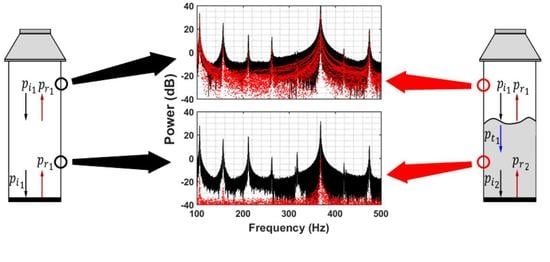A Detailed Insight into Acoustic Attenuation in a Static Bed of Hydrophilic Nanosilica
Abstract
:1. Introduction
2. Experimental
2.1. Experimental Setup
2.2. Nanosilica Powder
2.3. Measurements and Calibration
2.4. Methodology
3. Mathematical Model
3.1. Empty Bed
3.2. Static Granular Bed of Ultrafine Particles
4. Results and Discussion
4.1. Empty Column Dynamics under Acoustic Vibrations
4.2. Static Granular Nanosilica Bed Dynamics under Acoustic Vibrations
4.3. Signal Power
5. Conclusions
Author Contributions
Funding
Institutional Review Board Statement
Informed Consent Statement
Acknowledgments
Conflicts of Interest
Nomenclature
| speed of acoustic wave in the medium (m/s) | |
| acoustic intensity | |
| bulk modulus | |
| root mean square of sound pressure | |
| N | number of data points |
| instantaneous pressure/incident pressure (Pa) | |
| reflected pressure (Pa) | |
| transmitted pressure (Pa) | |
| average value of | |
| amplitude of the waves originating from the source (Pa) | |
| SPL | sound pressure level (dB) |
| distance from the distributor along the bed height (m) | |
| dimensionless distance from the distributor, i.e., (m/m) | |
| z | specific acoustic impedance |
| L | height of the acoustics source from distributor (m) |
| Greek symbols | |
| μ | air viscosity at room temperature (N·s m–2) |
| k | wave number |
| f | acoustic frequency |
| ω | angular frequency |
| λ | wavelength |
| α | acoustic power transmission coefficient |
| ρb | bulk density of the medium (kg/m3) |
| ε | bed porosity |
References
- Karimi, F.; Haghshenasfard, M.; Sotudeh-Gharebagh, R.; Zarghami, R.; Mostoufi, N. Multiscale characterization of nanoparticles in a magnetically assisted fluidized bed. Particuology 2020, 51, 64–71. [Google Scholar] [CrossRef]
- Ali, S.S.; Arsad, A.; Asif, M. Effect of modified inlet flow strategy on the segregation phenomenon in pulsed fluidized bed of ultrafine particles: A collapse bed study. Chem. Eng. Processing - Process Intensif. 2021, 159, 108243. [Google Scholar] [CrossRef]
- Raganati, F.; Chirone, R.; Ammendola, P. Gas–solid fluidization of cohesive powders. Chem. Eng. Res. Des. 2018, 133, 347–387. [Google Scholar] [CrossRef]
- Shabanian, J.; Chaouki, J. Influence of interparticle forces on solids motion in a bubbling gas-solid fluidized bed. Powder Technol. 2016, 299, 98–106. [Google Scholar] [CrossRef]
- Ali, S.S.; Al-Ghurabi, E.H.; Ajbar, A.; Mohammed, Y.A.; Boumaza, M.; Asif, M. Effect of Frequency on Pulsed Fluidized Beds of Ultrafine Powders. J. Nanomater. 2016, 2016, 12. [Google Scholar] [CrossRef] [Green Version]
- Fedorov, A.V.; Yazykov, N.A.; Bulavchenko, O.A.; Saraev, A.A.; Kaichev, V.V.; Yakovlev, V.A. CuFeAl Nanocomposite Catalysts for Coal Combustion in Fluidized Bed. Nanomaterials 2020, 10, 1002. [Google Scholar] [CrossRef] [PubMed]
- Ali, S.S.; Asif, M. Fluidization of nano-powders: Effect of flow pulsation. Powder Technol. 2012, 225, 86–92. [Google Scholar] [CrossRef]
- Asif, M.; Al-Ghurabi, E.H.; Ajbar, A.; Kumar, N.S. Hydrodynamics of Pulsed Fluidized Bed of Ultrafine Powder: Fully Collapsing Fluidized Bed. Processes 2020, 8, 807. [Google Scholar] [CrossRef]
- Lee, J.-R.; Lee, K.-S.; Park, Y.-O.; Lee, K.-W. Fluidization characteristics of fine cohesive particles assisted by vertical vibration in a fluidized bed reactor. Chem. Eng. J. 2020, 380, 122454. [Google Scholar] [CrossRef]
- Ali, S.S.; Basu, A.; Alfadul, S.M.; Asif, M. Nanopowder Fluidization Using the Combined Assisted Fluidization Techniques of Particle Mixing and Flow Pulsation. Appl. Sci. 2019, 9, 572. [Google Scholar] [CrossRef] [Green Version]
- Hoorijani, H.; Reza, Z.; Kamal, N.; Navid, M. Investigating the hydrodynamics of vibro-fluidized bed of hydrophilic titanium nanoparticles. Chem. Eng. Res. Des. 2021, 174, 486–497. [Google Scholar] [CrossRef]
- An, K.; Andino, J.M. Enhanced fluidization of nanosized TiO2 by a microjet and vibration assisted (MVA) method. Powder Technol. 2019, 356, 200–207. [Google Scholar] [CrossRef]
- Al-Ghurabi, E.H.; Shahabuddin, M.; Kumar, N.S.; Asif, M. Deagglomeration of Ultrafine Hydrophilic Nanopowder Using Low-Frequency Pulsed Fluidization. Nanomaterials 2020, 10, 388. [Google Scholar] [CrossRef] [PubMed] [Green Version]
- Ali, S.S.; Asif, M. Effect of particle mixing on the hydrodynamics of fluidized bed of nanoparticles. Powder Technol. 2017, 310, 234–240. [Google Scholar] [CrossRef]
- Zhao, Z.; Liu, D.; Ma, J.; Chen, X. Fluidization of nanoparticle agglomerates assisted by combining vibration and stirring methods. Chem. Eng. J. 2020, 388, 124213. [Google Scholar] [CrossRef]
- Al-Ghurabi, H.E.; Ajbar, A.; Asif, M. Improving Fluidization Hydrodynamics of Group C Particles by Mixing with Group B Particles. Appl. Sci. 2018, 8, 1469. [Google Scholar] [CrossRef] [Green Version]
- Ajbar, A.; Bakhbakhi, Y.; Ali, S.; Asif, M. Fluidization of nano-powders: Effect of sound vibration and pre-mixing with group A particles. Powder Technol. 2011, 206, 327–337. [Google Scholar] [CrossRef]
- Xu, X.; Fu, Y.; Song, S.; Dong, L.; Lv, B.; Chen, Z.; Tian, Y.; Chen, J. Fluidization and separation characteristics of a gas–solid separation fluidized bed in the presence of an acoustic field. Chem. Eng. Res. Des. 2021, 169, 46–53. [Google Scholar] [CrossRef]
- Peng, C.; Chena, M.; Spicerb, J.B.; Jiang, X. Acoustics at the nanoscale (nanoacoustics): A comprehensive literature review. Part I: Materials, devices and selected applications. Sens. Actuators A Phys. 2021, 332, 112719. [Google Scholar] [CrossRef]
- Zhu, C.; Liu, G.; Yu, Q.; Pfeffer, R.; Dave, R.N.; Nam, C.H. Sound assisted fluidization of nanoparticle agglomerates. Powder Technol. 2004, 141, 119–123. [Google Scholar] [CrossRef]
- Lv, B.; Deng, X.; Chen, J.; Fang, C.; Zhuc, X. Effects of sound fields on hydrodynamic and dry beneficiation of fine coal in a fluidized bed. Sep. Purif. Technol. 2021, 254, 117575. [Google Scholar] [CrossRef]
- Ammendola, P.; Chirone, R.; Raganati, F. Fluidization of binary mixtures of nanoparticles under the effect of acoustic fields. Adv. Powder Technol. 2011, 22, 174–183. [Google Scholar] [CrossRef]
- Ammendola, P.; Chirone, R. Aeration and mixing behaviours of nano-sized powders under sound vibration. Powder Technol. 2010, 201, 49–56. [Google Scholar] [CrossRef]
- Si, C.; Wu, J.; Wang, Y.; Zhang, Y.; Liu, G. Effect of acoustic field on minimum fluidization velocity and drying characteristics of lignite in a fluidized bed. Fuel Processing Technol. 2015, 135, 112–118. [Google Scholar] [CrossRef]
- Xu, C.; Cheng, Y.; Zhu, J. Fluidization of fine particles in a sound field and identification of group C/A particles using acoustic waves. Powder Technol. 2006, 161, 227–234. [Google Scholar] [CrossRef]
- Herrera, C.A.; Levy, E.K.; Ochs, J. Characteristics of acoustic standing waves in fluidized beds. AIChE J. 2002, 48, 503–513. [Google Scholar] [CrossRef]
- Kumar, T.S.; Patle, M.K.; Sujith, R.I. Characteristics of acoustic standing waves in packed-bed columns. AIChE J. 2007, 53, 297–304. [Google Scholar] [CrossRef]
- Cherntongchai, P.; Chaiwattana, S.; Leruk, R.; Panyaruean, J.; Sriboonnak, S. Influence of standing wave characteristics on hydrodynamic behaviours in sound-assisted fluidization of Geldart group A powder. Powder Technol. 2019, 350, 123–133. [Google Scholar] [CrossRef]
- Al-Ghurabi, E.H.; Ali, S.S.; Alfadul, S.M.; Shahabuddin, M.; Asif, M. Experimental investigation of fluidized bed dynamics under resonant frequency of sound waves. Adv. Powder Technol. 2019, 30, 2812–2822. [Google Scholar] [CrossRef]
- Ali, S.S.; Hossain, S.K.S.; Asif, M. Dynamics of partially collapsing pulsed fluidized bed. Can. J. Chem. Eng. 2021, 99, 2333–2344. [Google Scholar] [CrossRef]
- Ali, S.S.; Al-Ghurabi, E.H.; Ibrahim, A.A.; Asif, M. Effect of adding Geldart group A particles on the collapse of fluidized bed of hydrophilic nanoparticles. Powder Technol. 2018, 330, 50–57. [Google Scholar] [CrossRef]
- Reynolds, D.D. Engineering principles of acoustics: Noise and Vibration Control/Douglas D. Reynolds; Allyn and Bacon: Boston, MA, USA, 1981. [Google Scholar]
- Regtien, P.; Dertien, E. 9-Acoustic sensors. In Sensors for Mechatronics, 2nd ed.; Regtien, P., Dertien, E., Eds.; Elsevier Publishing: Amsterdam, The Netherlands, 2018; pp. 267–303. [Google Scholar]
- Hansen, C.H. Fundamentals of acoustics. In Occupational Exposure to Noise: Evaluation, Prevention and Control; Goelzer, B.H., Hansen, C.H., Sehrndt, G.A., Eds.; World Health Organization: Geneva, Switzerland, 2001. [Google Scholar]
- Kaliyaperumal, S.; Barghi, S.; Zhu, J.; Briens, L.; Rohani, S. Effects of acoustic vibration on nano and sub-micron powders fluidization. Powder Technol. 2011, 210, 143–149. [Google Scholar] [CrossRef]
- Atkinson, C.M.; Kytömaa, H.K. Acoustic wave speed and attenuation in suspensions. Int. J. Multiph. Flow 1992, 18, 577–592. [Google Scholar] [CrossRef]
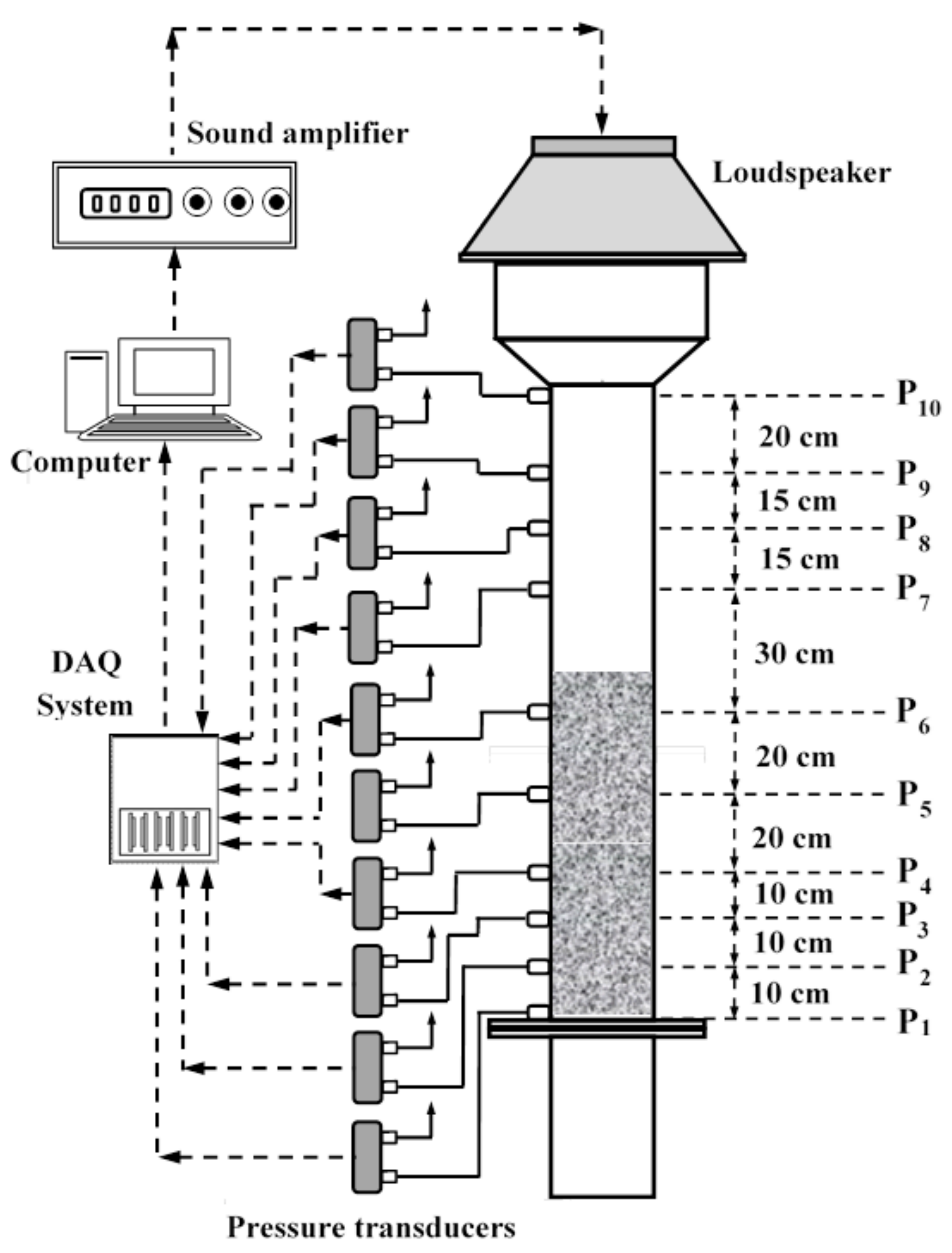
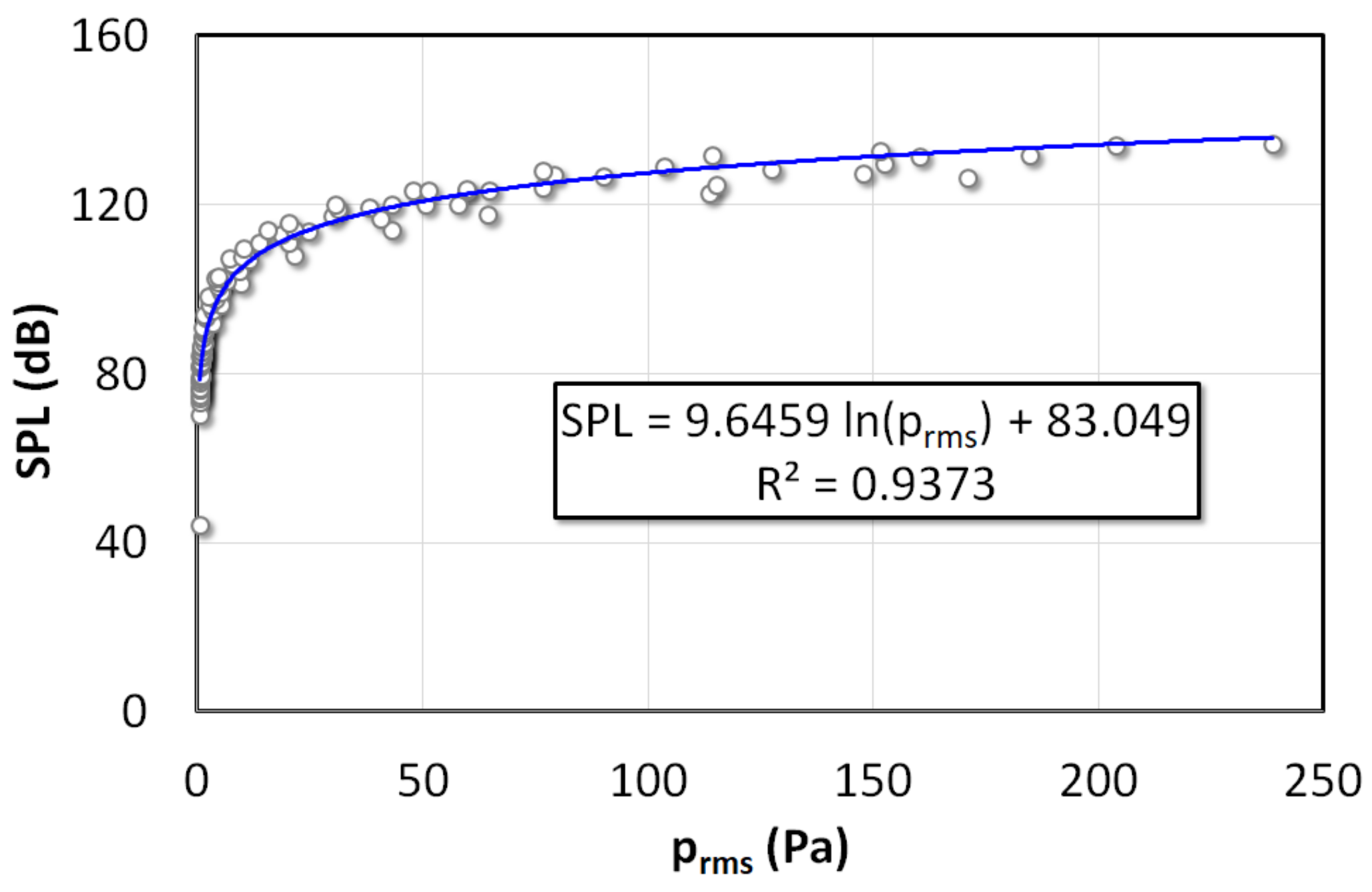
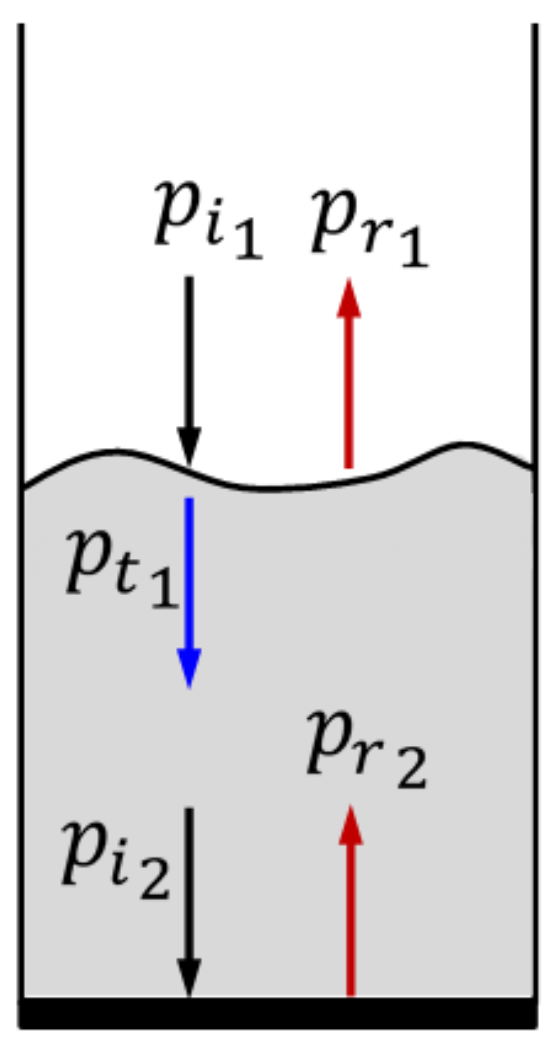


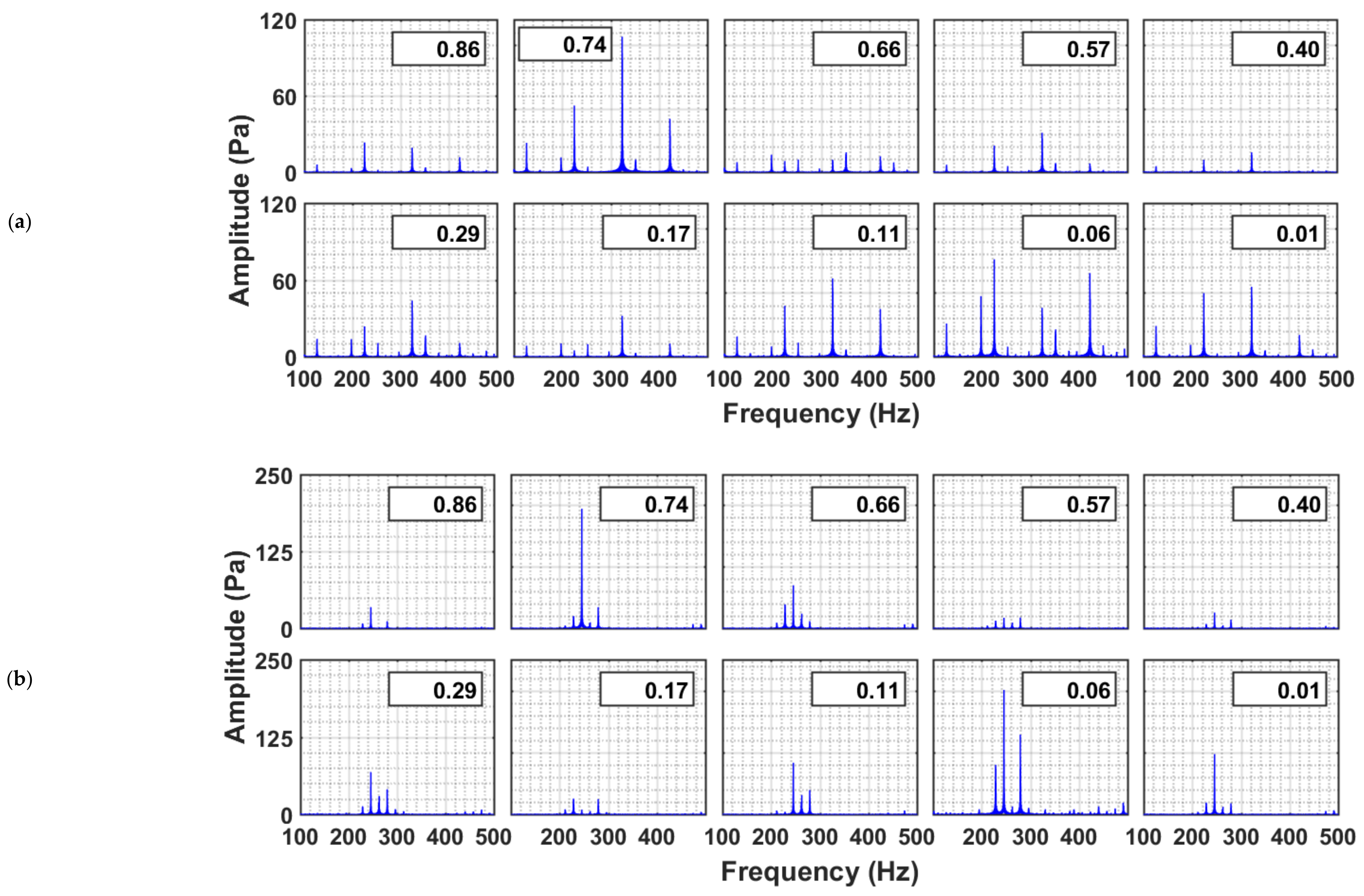


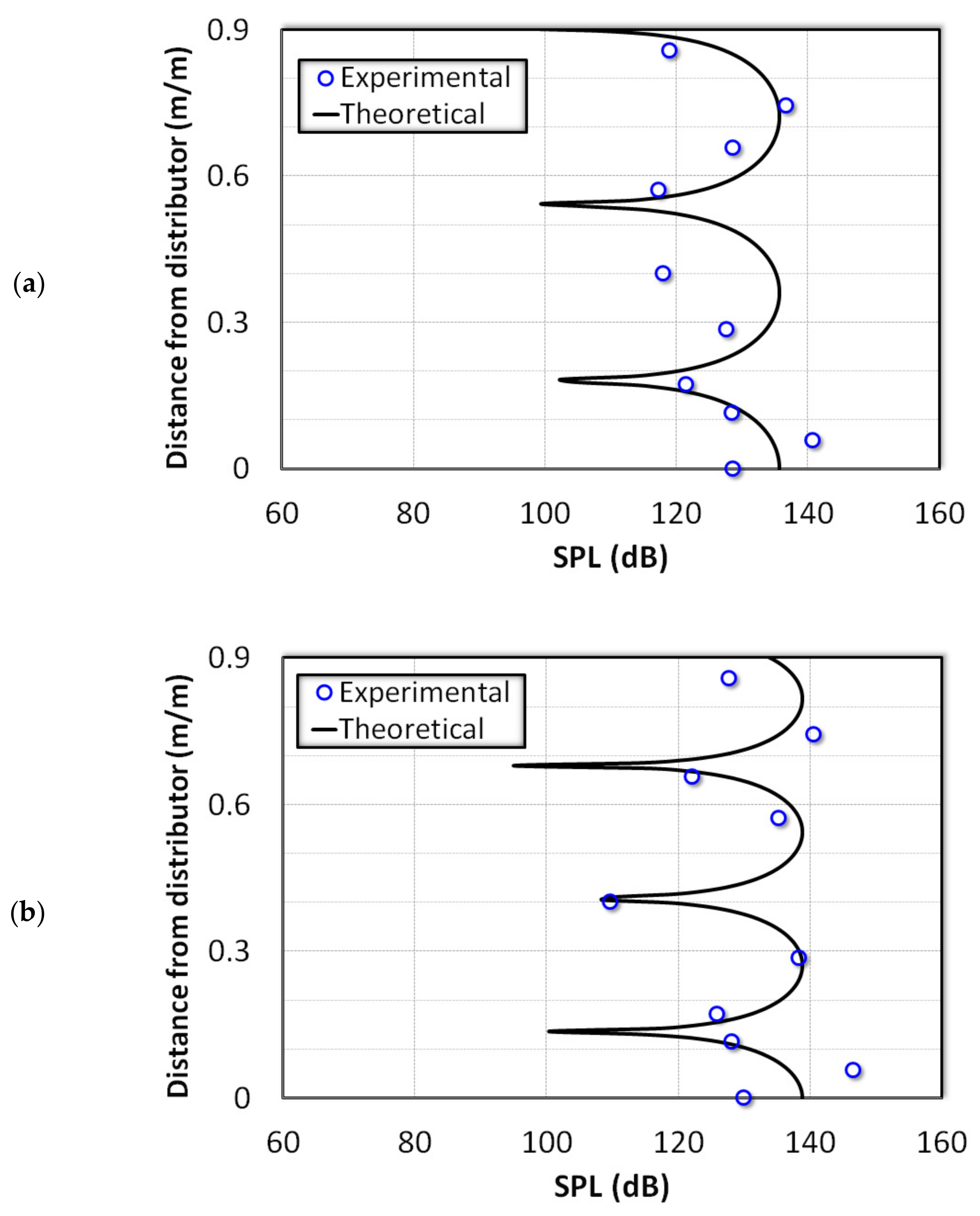

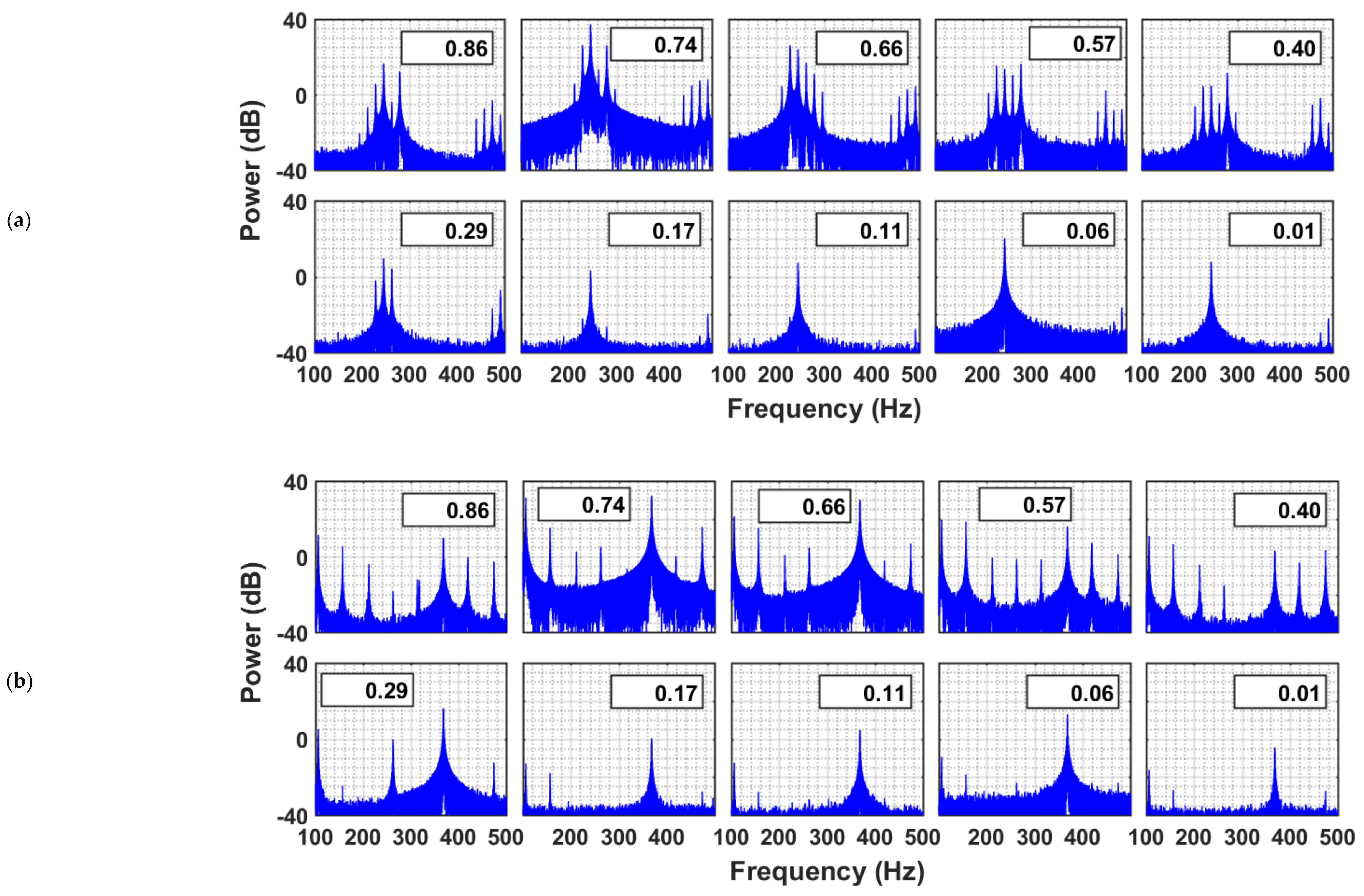
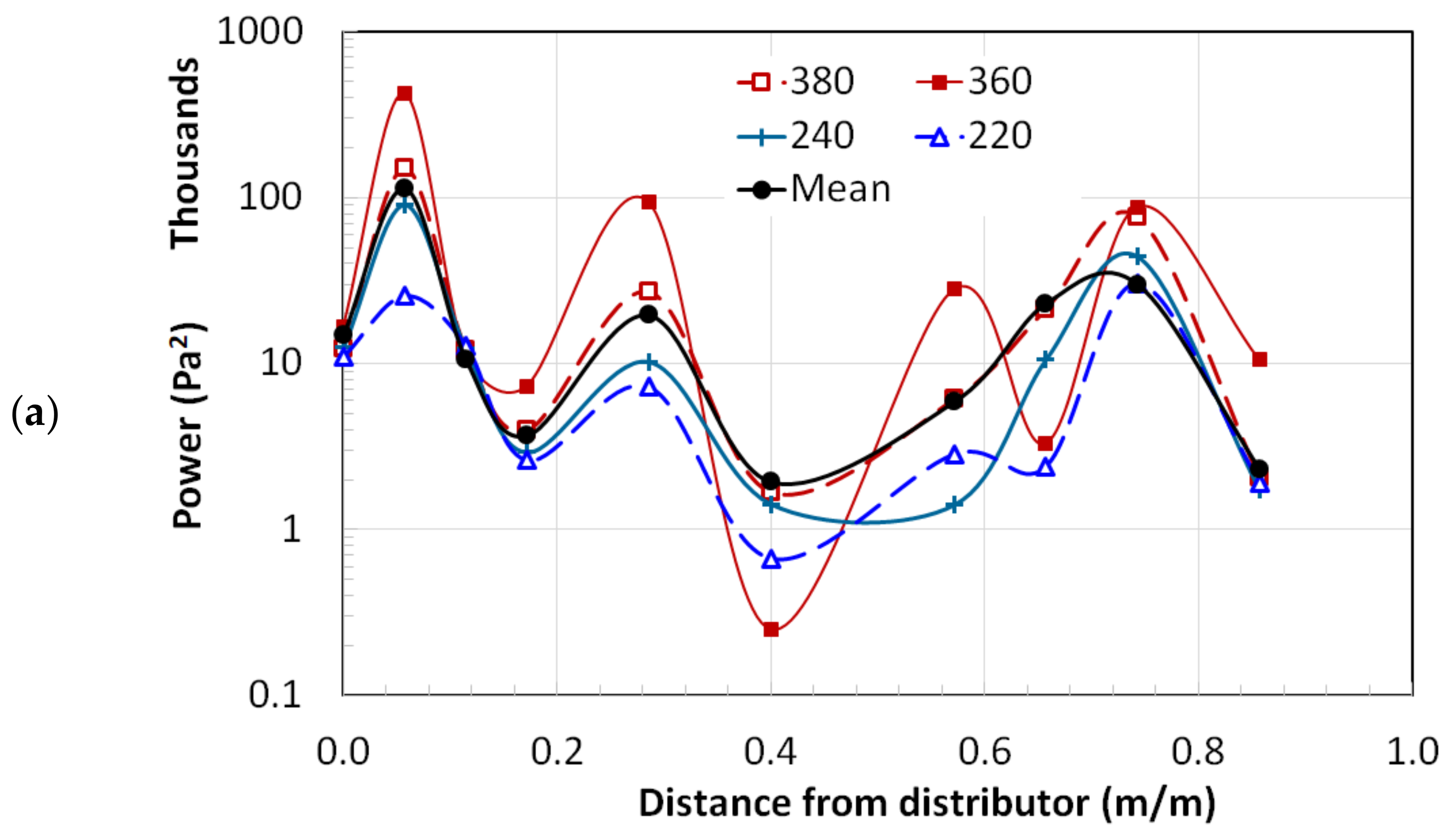
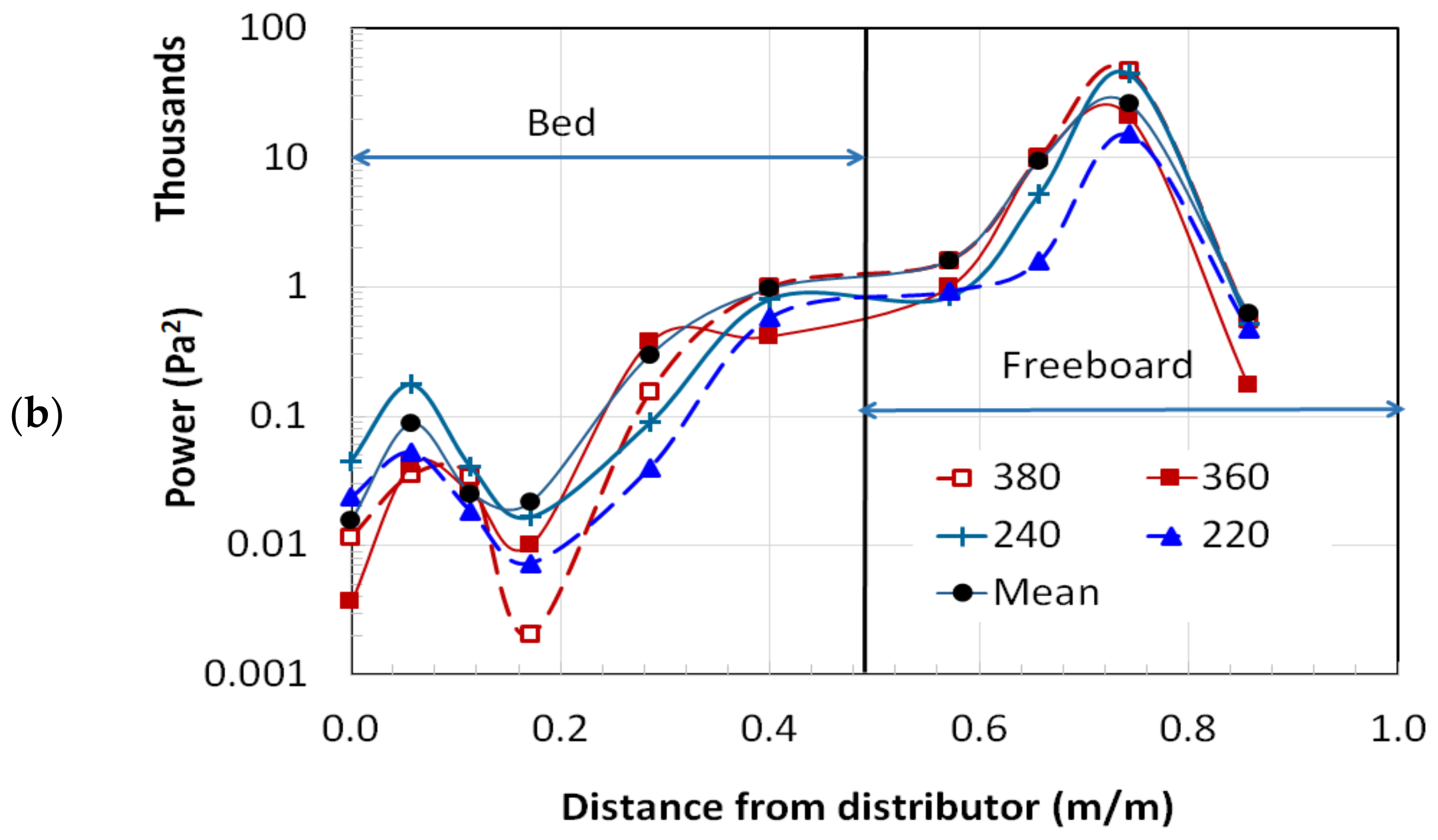
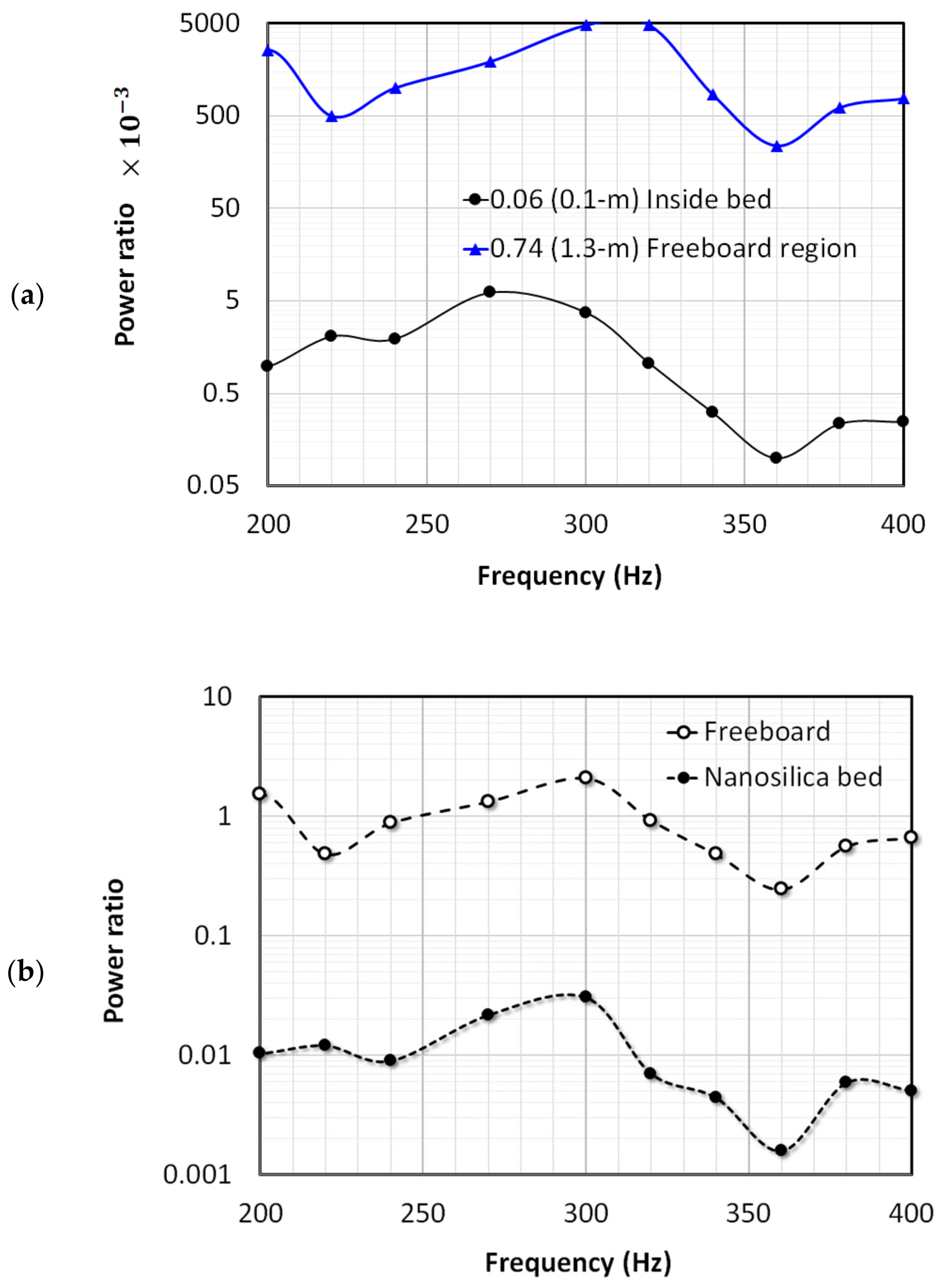
| Pressure Port | P1 | P2 | P3 | P4 | P5 | P6 | P7 | P8 | P9 | P10 |
|---|---|---|---|---|---|---|---|---|---|---|
| Location, x (m) | 0.01 | 0.1 | 0.2 | 0.3 | 0.5 | 0.7 | 1.0 | 1.15 | 1.3 | 1.5 |
| Location (m/m) | 0.01 | 0.06 | 0.11 | 0.17 | 0.29 | 0.40 | 0.57 | 0.66 | 0.74 | 0.86 |
Publisher’s Note: MDPI stays neutral with regard to jurisdictional claims in published maps and institutional affiliations. |
© 2022 by the authors. Licensee MDPI, Basel, Switzerland. This article is an open access article distributed under the terms and conditions of the Creative Commons Attribution (CC BY) license (https://creativecommons.org/licenses/by/4.0/).
Share and Cite
Ali, S.S.; Arsad, A.; Hossain, S.S.; Asif, M. A Detailed Insight into Acoustic Attenuation in a Static Bed of Hydrophilic Nanosilica. Nanomaterials 2022, 12, 1509. https://doi.org/10.3390/nano12091509
Ali SS, Arsad A, Hossain SS, Asif M. A Detailed Insight into Acoustic Attenuation in a Static Bed of Hydrophilic Nanosilica. Nanomaterials. 2022; 12(9):1509. https://doi.org/10.3390/nano12091509
Chicago/Turabian StyleAli, Syed Sadiq, Agus Arsad, SK Safdar Hossain, and Mohammad Asif. 2022. "A Detailed Insight into Acoustic Attenuation in a Static Bed of Hydrophilic Nanosilica" Nanomaterials 12, no. 9: 1509. https://doi.org/10.3390/nano12091509
APA StyleAli, S. S., Arsad, A., Hossain, S. S., & Asif, M. (2022). A Detailed Insight into Acoustic Attenuation in a Static Bed of Hydrophilic Nanosilica. Nanomaterials, 12(9), 1509. https://doi.org/10.3390/nano12091509







